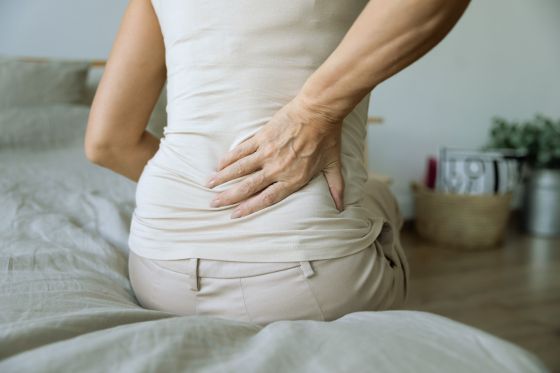Lower back pain while sleeping is a frustrating issue that can significantly impact your quality of life.
When rest should be a time for your body to recover and rejuvenate, persistent pain can turn sleep into a nightly struggle.
As someone who has seen countless cases of lower back pain, I can tell you that the causes are often linked to how we sleep, the positions we adopt, and even the surfaces we sleep on.
The Causes of Lower Back Pain While Sleeping
When it comes to lower back pain while sleeping, several factors can contribute to this discomfort.
Understanding these causes is the first step toward finding relief.
1. Poor Sleep Posture
One of the most common culprits behind lower back pain while sleeping is poor sleep posture.
The way you position your body while lying down can have a significant impact on your spine’s alignment.
For example, sleeping on your stomach can cause your spine to arch in an unnatural way, putting strain on your lower back.
On the other hand, sleeping on your back or side with proper support can help maintain the natural curve of your spine, reducing the risk of pain.
2. Unsupportive Mattress
The type of mattress you sleep on plays a crucial role in the health of your spine.
An old, saggy mattress may not provide the support your lower back needs, leading to discomfort during the night.
Conversely, a mattress that is too firm can also cause problems by creating pressure points.
The ideal mattress is one that offers a balance between support and comfort, allowing your spine to rest in its natural alignment.
3. Lack of Movement
Staying in one position for an extended period, as we often do during sleep, can lead to stiffness and lower back pain.
This is particularly true if you already have underlying issues like muscle imbalances or spinal problems.
Movement throughout the day is essential for maintaining flexibility and preventing pain, so if you lead a sedentary lifestyle, the lack of movement can exacerbate discomfort during sleep.
4. Stress and Tension
Emotional stress can manifest physically, and one of the areas it commonly affects is the lower back.
If you’re carrying a lot of stress, you may notice that your lower back feels tight or sore, especially at night when you’re trying to relax.
Tension in the muscles surrounding the spine can cause discomfort that disrupts your sleep.
Symptoms of Lower Back Pain While Sleeping
Identifying the symptoms of lower back pain while sleeping can help you take the necessary steps to address the issue.
Here are some common signs:
- Morning Stiffness:
Waking up with stiffness or tightness in your lower back that gradually improves as you move around is a common symptom.
- Pain Upon Waking:
Experiencing sharp or dull pain in your lower back as soon as you get out of bed can indicate that your sleep position or mattress is causing strain.
- Difficulty Finding a Comfortable Position:
If you find yourself tossing and turning throughout the night, unable to find a position that relieves your lower back pain, it’s a sign that something needs to change.
- Pain That Worsens With Certain Movements:
Lower back pain that intensifies when you change positions in bed or when you get up in the morning may be related to how your spine is aligned during sleep.
Solutions for Lower Back Pain While Sleeping
Fortunately, there are several strategies you can implement to alleviate lower back pain while sleeping and ensure a more restful night.
1. Improve Your Sleep Posture
The first step to reducing lower back pain while sleeping is to evaluate and adjust your sleep posture.
If you’re a stomach sleeper, try transitioning to sleeping on your back or side, as these positions are generally better for spinal alignment.
When sleeping on your side, place a pillow between your knees to keep your hips, pelvis, and spine in a neutral position.
If you prefer sleeping on your back, placing a pillow under your knees can help maintain the natural curve of your spine.
2. Invest in a Supportive Mattress
Consider upgrading your mattress if it’s no longer providing the support your lower back needs.
Look for a medium-firm mattress that supports the natural curves of your body without creating pressure points.
If you’re not ready to invest in a new mattress, a mattress topper made of memory foam or latex can offer additional support and cushioning.
3. Stretch Before Bed
Incorporating gentle stretches into your bedtime routine can help relieve tension in your lower back and prepare your body for a more comfortable night’s sleep.
Focus on stretches that target the muscles around your spine, such as the cat-cow stretch, child’s pose, and seated forward bend.
These stretches can improve flexibility and reduce stiffness, making it easier to maintain a comfortable sleep posture.
4. Manage Stress
If stress is contributing to your lower back pain, it’s important to find ways to relax and unwind before bed.
Deep breathing exercises, meditation, and yoga are all effective techniques for reducing stress and tension in the body.
Additionally, establishing a calming bedtime routine, such as taking a warm bath or reading a book, can help signal to your body that it’s time to relax and sleep.
5. Stay Active During the Day
Regular physical activity is essential for maintaining the health of your spine and preventing lower back pain.
Incorporate exercises that strengthen your core muscles, as a strong core provides stability and support for your lower back.
Activities like walking, swimming, and yoga are also great for improving flexibility and reducing the risk of stiffness during sleep.
6. Seek Professional Help
If you’ve tried making adjustments to your sleep environment and habits but are still experiencing lower back pain while sleeping, it may be time to consult with a professional.
At Tomsic Physical Therapy, we specialize in helping individuals overcome lower back pain through personalized treatment plans.
Whether it’s through physical therapy, posture correction, or other therapeutic techniques, we’re here to help you find relief and get back to enjoying restful, pain-free nights.
When to Seek Immediate Medical Attention:
Lower back pain while sleeping can be a significant obstacle to getting the rest your body needs.
By understanding the causes and implementing the strategies outlined above, you can take control of your sleep and reduce or even eliminate the discomfort that’s been keeping you awake.
Remember, the quality of your sleep directly impacts your overall health and well-being.
Don’t let lower back pain hold you back from living your best life.
If you’re struggling with persistent lower back pain while sleeping, we’re here to help.
Contact Tomsic Physical Therapy today to schedule a consultation and discover how we can support you on your journey to a pain-free life.
Sleep well, live well, and let’s make lower back pain a thing of the past together.
Free Resources at Tomsic Physical Therapy
At Tomsic Physical Therapy, we’re dedicated to ensuring that back pain doesn’t hold you back from living life to the fullest.
As the leading experts in back pain relief in Durango, we’ve helped countless patients reclaim their favorite activities, free from the burden of discomfort.
Ready to embark on your journey toward lasting relief from lower back pain?
We offer a variety of free resources designed to help you take control of your health:
- Download Our Free Back Pain Report: This comprehensive guide is packed with practical tips and insights to help you manage and reduce back pain effectively.
- Schedule a Free Telephone Consultation: Have a one-on-one conversation with our experts about your specific back pain challenges and explore personalized treatment options.
- Visit Our Clinic for a Free Discovery Session: Come see us in person to experience how our specialized treatments can be tailored to your needs, helping you regain control and live pain-free.
Don’t let back pain define your life.
Reach out to us today, and let’s work together to create a vibrant, active, and pain-free future.
Your journey to a healthier, more fulfilling life starts now.
Other Free Resources For Back Pain Relief
If you want to stay up to date with the latest advice on back pain treatments, you can follow us on social media and read our expert articles.
Read Our Blog – Back Pain from Rib Injury: Understanding the Pain
Read Our Blog – How To Stop Back Pain On Vacation And Enjoy Summer!
Follow us on Facebook, Instagram, and LinkedIn for more free tips and updates from our physical therapy clinic in Durango.

